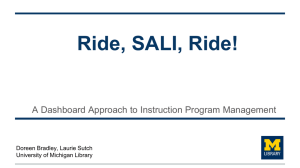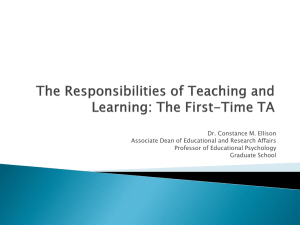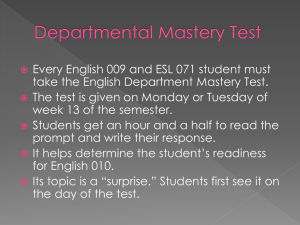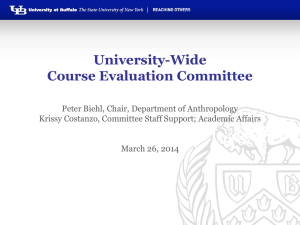Span of Control as a Factor of Class Size in Education
advertisement
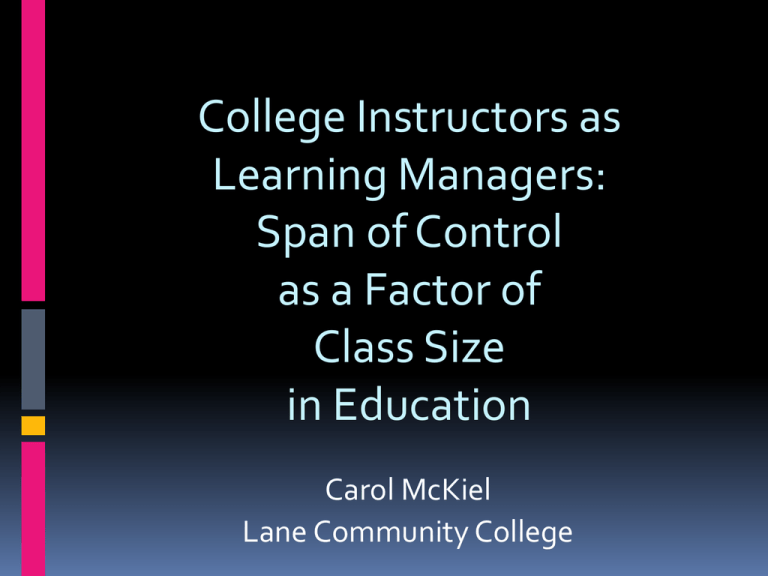
College Instructors as Learning Managers: Span of Control as a Factor of Class Size in Education Carol McKiel Lane Community College What Is Span of Control? o Ratio of manager to employees o Different institutions have identified a specific number of employees a manager can effectively supervise Application of Span of Control o Emergency response • 1:8 supervisor to workers • Greater safety o Military • 1:5 team leader to soldiers o Prisons • 1:4 guard to inmates • 1:15 increase in violence o Education – elementary school • 1:12 principal to teachers • Wider span negatively impacts student outcomes (Mears, 2004; Meier & Bohte, 2003) In the interest of improving student outcomes… Many business practices applied in education. Why not span of control? If the ratio of manager to employee is so critical for positive outcomes... Why debate class size? History of Span of Control Workplace in the Past Managers control employees’ behaviors Gulick (1937 ) identified most effective span of control ratio 1:10 3 Productivity Factors Impact Size of Span of Control Workplace in the Past Managers control employees’ behaviors More of any one factor = Fewer employees Factors impact ability to control 1. Training • Experience level of employees 2. Distance between the manager and employees • Physical distance requires more time 3. Diversity of Function • • Different types of employee jobs Different levels of employee skills Today’s Workplace Managers do not control but engage with workers Management theories are about collaboration o McGregor’s Theory X & Theory Y • X – authoritarian mgr thinks lazy employee • Y – collaborative mgr thinks capable employee • Collaboration = higher productivity o Herzberg’s Motivation Theory • Employee engagement = Job satisfaction = Productivity o Change in management philosophy changed span of control • Management structures flattened • Increased span of control 1:30 (Herzberg, 2003; McGregor, 1960) Span of Control Is Now about Relationships o For employee satisfaction – • Managers need to work more closely with their employees o Employees state they want a relationship with their manager o Employees wanted: • Feedback • Guidance • Support • Emotional • Psychological (Doran et al., 2004; Shirey, 2006) Span of Control and Employee Productivity 1 manager : 30 employees redundant non-skilled labor 1 manager : 10 employees complex thinking problem-solving creative labor (Gittell, 2001;Hattrup & Kleiner, 1993; McManus, 2007) Relationship with Employee o Impacts productivity • Small ratio: 10 employees • Problem-solve with employees • Help workers develop skills • Wide ratio: >10 employees • Monitor for compliance - Discipline non-compliance • Difficult to meet each person’s needs (Gittell, 2001) It takes time… o Develop one-on-one relationships • Complex problems require deeper discussion • Higher level skills need more guidance • Business recognizes the return on investment and willing to pay for a small span of control • Small span of control – 1:6.5 • Companies experience 20% growth rate • Median span of control – 1:8 • Companies have less than a 20% growth rate (Davison, 2003; Hattrup & Kleiner, 1997) Higher Education o Large classes 1:25 or more 100 students/term • Difficult to address individual learning needs • Monitor for compliance • Information flows one way from instructor • One size fits all teaching method • Teach/learn in lower levels of Bloom’s taxonomy • Knowledge, comprehension, application (Baxter Magolda, 2004; Leland & Kasten, 2002) Higher Education Large groups can be effective method for passing content to millions of people. Higher Education Complex nature of today’s world has shifted educational outcomes… Higher level skills needed. Skills People Need to Develop in Higher Education “People need to be able to use knowledge flexibly in different contexts.” (Leland & Kasten, 2002, p. 72) “Interaction and collaboration are now important in most workplaces, and are expected to be even more important in the future.” (Livingston, 2010, p. 59) Skill Development and Higher Ed “The goal of school cannot simply be dissemination, but rather, must be the absorption of material.” Livingston, 2010, p. 60 “Higher education focused on knowledge acquisition has trained students to be transitional knowers.” Baxter Magolda (as cited in Hunter, Laursen, & Seymour, 2007, p. 66) Higher Education & Skill Development We need graduates capable of complex thinking and creative problem-solving. “If you expect someone to do something, you have to expect to teach them how.” (Kuh et al., 2005, p. 66) Relationships Between Faculty and Students Is Important for Skill Development o One-on-one relationships with faculty … • Students show significant gains in critical thinking (Hayes & Devitt, 2008) “There is no substitute for periodic personal contact between students and faculty,” (Tinto, 1987, p. 167) The Discrepancy In the workplace creativity and problem-solving 1:10 In the classroom critical thinking and problem-solving 1:25 The ratio business recognizes as suitable for low-skilled, redundant labor The Question o Why the discrepancy? o What is the nature of the work of managers and instructors? ? Are There Commonalities in Managers’ and Instructors’ Work? Both take care of needs of people and help them develop. Maslow’s theory explains the nature of human need and relationships. Applied in business and education Maslow’s Hierarchy of Needs 1. Physical • Lighting, temperature, and lunch 2. Safety – not just physical safety • Emotional security 3. Need to belong • Membership in a satisfying group 4. Self esteem • Personal value within the group 5. Self Actualized • Understanding of self • Context with others Maslow’s Theory: commonality between business and education If elements of Maslow’s theory embedded in span of control Then possible support for span of control in education Span of Control Literature 5 management functions related to Maslow’s Theory In span of control practices… Managers a) provide motivation b) promote communication c) foster independence d) build relationships e) develop a collaborative work environment Are the 5 factors found in management and education literature? Similarities in Education and Management Literature Foundation Theorists Vincent Tinto Frederick Herzberg Leaving College Motivation-Hygiene Theory 1987 2003 George Kuh Douglas McGregor National Survey of Student Engagement (NSSE) The Human Side of Enterprise Indiana University Controlling vs Collaborative 2005 Management Practices Theory X and Theory Y 1960 Education and Management Literature Shows Similarities Provide Motivation Faculty feedback motivates students to submit polished articles. Kuh Manager feedback focusing on improving employee competence improves motivation. Herzberg Education and Management Literature Shows Similarities Promote Communication Students identify that high quality interactions with faculty impact academic development. Kuh Robust discussions are important in order for managers and employees to clarify functions and tasks. McGregor Education and Management Literature Shows Similarities Build Relationships There is no substitute for periodic personal contact between students and faculty. Tinto Satisfying the human need to belong to a group increases employee satisfaction and results in higher productivity. McGregor Education and Management Literature Shows Similarities Foster Independence Instructors help students develop their potential by engaging them formally and informally. Tinto Managers should work closely with employees in order to help them construct job skills and promotion paths. Herzberg Education and Management Literature Shows Similarities Develop a Collaborative Environment Integrating students into the campus culture satisfies their need to belong. If this does not happen, students satisfy the need to belong somewhere else. Tinto People are interdependent in their work. When people work positively with each other, they are more satisfied about their jobs. McGregor In the literature: Similarities between management and instruction within the 5 management functions What About the Attitudes of Managers and Instructors? o Are they alike in their thinking of their work with people? o Do they have similar expectations? ? Study of Manager and Instructor Perceptions about Their Work with People The Research o Community college o 4 managers and 4 instructors • 4 women and 4 men • At least 5 years experience on the job • Good reputations of working well with others Research Methods o Q method – study/compare people’s perceptions o Focus group – participants share ideas Q Method o Allows the researcher to compare participants’ attitudes about a topic. Developed by William Stephenson in 1935 Current Q Method Expert – Steven Brown For more information about Q Method go to qmethod.org Q Method Is Not a Survey In a survey… What factors are important for improving schools? Participant A and Participant B 1. I think we should decrease class size. 2. I think we should increase teacher qualifications. 3. I think we should increase the number of days. X X X • Two people answer “strongly agree” for all statements. • The participants appear to value each statement the same. • The participants appear to share the same view. Q Method Is Different From a Survey The researcher has a stronger tool to study and compare participants’ attitudes. o Participants compare each statement with every other statement o Rank orders the statements from “most agree” to “most disagree” o Only 1 statement can be “most agree” Statements Sorted in Order of Preference o Only 1 statement can be “most agree” Participant A Increase Increase the teacher number of qualifications days 1. Most agree 3. Least agree 2. Neutral Decrease class size o Differences in people’s attitudes show up when they must decide on “most agree.” Participant A B Increase Increase the teacher number of qualifications days 1. Most agree 3. Least agree 2. Neutral 2. Neutral 1. Most agree 3. Least agree Decrease class size In the survey, participant A and B looked the same. Using Q Method, the researcher has a better understanding of the participants’ attitudes. o Similarity only if preference ranking is the same. Participant A B Increase Increase the Decrease teacher number of class size qualifications days 1. Most agree 3. Least agree 2. Neutral 1. Most agree 2. Neutral 3. Least agree o Similarity only if preference ranking is the same. Participant A B Increase Increase the Decrease teacher number of class size qualifications days 1. Most agree 3. Least agree 2. Neutral 2. Neutral 3. Least agree 1. Most agree o Agreement in all areas is unlikely o Significant if agreement exists. Participant A B Increase Increase the Decrease teacher number of class size qualifications days 1. Most agree 3. Least agree 2. Neutral 1. Most agree 3. Least agree 2. Neutral Setting Up the Q Method o Step 1 – Develop the Statements • Use the literature from the field • Identify at least two themes In the Study Comparing Managers and Instructors Attitudes o Theme 1 5 Management Functions of Span of Control a) provide motivation b) promote communication c) foster independence d) develop a collaborative work environment e) build relationships In the Study Comparing Managers and Instructors Attitudes o Theme 2 McGregor’s Management Theory Theory X – Authoritarian Theory Y - Collaborative Developing the Statements to Sort o Use the 2 themes to form a grid 5 x 2 grid – 10 intersect cells providing motivation Theory X (authoritarian) Theory Y (collaborative) Motivation/authoritarian Motivation/collaborative providing motivation promoting communication fostering independence fostering independence fostering independence developing a collaborative work environment developing a collaborative work environment building relationships building relationships developing a collaborative work environment Relationships/collaborative Develop the Statements Using the Themes o 3 statements per cell • 30 statements Affective Management Functions of Span of Control Management Theory X (authoritarian) 1. Providing Motivation (M) 2. 3. 1. Promoting 2. Communication (C) 3. 1. Fostering 2. Independence People often require reward and punishment in order to become motivated. (1XM) People are reluctant to take on the responsibilities needed to do the task. My role is to push them, so they will work hard. (3XM) People want to be closely directed in their activities. (5XM) I need to tell people how to do every detail of a task, so they can complete the task effectively. (7XC) Individuals need to know about the mistakes they make. (9XC) Communication is important for getting people to do their assigned tasks. (11XC) Individuals develop primarily because of my pressure on them to perform. (13XI) An objective of my job is the get individuals to do their work Management Theory Y (cooperative) 1. People are basically self-motivating; my role is to remove barriers and provide support, so they can perform their tasks well. (2YM) 2. People enjoy taking on responsibility. My role is to help them do this. (4YM) 3. People learn to exercise self-direction under appropriate conditions. (6YM) 1. I need to provide coaching and feedback to people, so they can complete a task appropriately. (8YC) 2. Individuals need to be recognized for jobs well done. (10YC) 3. Communication is important for providing support for people to accomplish their tasks. (12YC) 1. I encourage individuals to take the initiative with their tasks. (14YI) 2. An objective of my job is to help individuals develop their unique capacities. (16YI) The Codes for the Statements X= Authoritarian management philosophy Y=Collaborative management philosophy M = provide motivation C = promote communication I = foster independence DC = develop a collaborative work environment R = build relationships The Statements 1. People often require reward and punishment in order to become motivated. (XM) 2. People are basically self-motivating; my role is to remove barriers and provide support, so they can perform their tasks well. (YM) 3. People are reluctant to take on the responsibilities needed to do the task. My role is to push them, so they will work hard. (XM) 4. People enjoy taking on responsibility. My role is to help them do this. (YM) 5. People want to be closely directed in their activities. (XM) 6. People learn to exercise self-direction under appropriate conditions. (YM) 7. I need to tell people how to do every detail of a task, so they can complete the task effectively. (XC) 8. I need to provide coaching and feedback to people, so they can complete a task appropriately. (YC) 9. Individuals need to know about the mistakes they make. (XC) 10. Individuals need to be recognized for jobs well done. (YC) 11. Communication is important for getting people to do their assigned tasks. (XC) 12. Communication is important for providing support for people to accomplish their tasks. (YC) 13. Individuals develop primarily because of my pressure on them to perform. (XI) 14. I encourage individuals to take the initiative with their tasks. (YI) 15. An objective of my job is the get individuals to do their work effectively. (XI) 16. An objective of my job is to help individuals develop their unique capacities. (YI) 17. Part of my job is to keep constant pressure on people in order to keep them working hard. (XI) 18. In general, people are quite capable, and I only have to help them see their capacities for them to do the work. (YI) 19. My role is to establish an environment where people learn that good work is rewarded and mistakes are not acceptable. (XDC) 20. My role is to establish an environment where people feel safe enough to take the risks necessary to improve their skills. (YDC) 21. The environment is not as important as my message to individuals that I expect them to work hard. (XDC) 22. Individuals need to feel part of a cohesive group in order to do their jobs well. (YDC) 23. People work best when one person determines the goals for them. (XDC) 24. People work best when there are shared goals that they helped establish. (YDC) 25. My relationship with individuals centers around my authority to set the work agenda. (XR) 26. Engaging with individuals to form positive, give-and-take relationships is important to helping them do their work effectively. (YR) 27. I am concerned with the quality of the work. My relationships with people is not as important. (XR) 28. I am concerned with the quality of my relationships with individuals. If the relationship is good, people will perform better. (YR) 29. My relationship with individuals is not as important as making sure they know what is expected of them. (XR) 30. Building relationships with people is critical to promoting positive outcomes in individuals. (YR) Step 2 - Participants Sort the Statements o Statements are placed on index cards o Sort each statement (card) in preference order from 1 to 30 “most agree” to “most disagree” The Sort o Statements are placed on a grid. o Simpler than linear placement. o Stephenson: statistically sound to use a grid. o Participants place statements in columns. (wikipedia) Most agree to Most disagree The Sort o Participants sort the statements • Rank each statement from most agree to most disagree (wikipedia) card 5 card card 2 4 card 3 Most agree to card 1 Most disagree Sort Results Instructor 4 30 15 18 20 2 9 19 22 14 10 1 5 17 24 28 8 6 21 13 29 7 12 26 16 11 4 3 27 23 25 Statement placement results for Instructor 4 Sort Results Instructor 4 24 15 18 0 0 20 2 9 19 +1 0 0 -1 22 14 10 1 5 17 +2 +1 0 0 -1 -2 28 8 6 21 13 29 7 +1 0 0 -1 -2 -3 16 11 4 3 27 23 25 +1 0 0 -1 -2 -3 -4 +3 +2 30 +4 12 26 +3 +2 o Each statement assigned score based on placement o The statement values used for factor analysis Q Method – Data Analysis o Compare the participants’ sorts o Look for correlations between participant opinions • Use a modified Pearson r r=1-∑(x-y)2/x2 (Brown, 1991) Sort Results – Data Analysis Perfect Correlation: r=1.00 Significance >.45 I1 I2 I3 I4 M1 0.57 0.51 0.58 0.78 M2 0.62 0.64 0.48 0.63 M3 0.64 0.64 0.66 0.86 M4 0.69 0.70 0.63 0.74 Significant agreement between managers and instructors on the way they placed their statements. Q Method – Data Analysis Managers and instructors sorted themselves into 1 group. Showed significant similarity in their thinking. blue statements=Collaborative yellow statements =Authoritarian Managers and Instructors favor the Theory Y – Collaborative Strong Correlation of Statement Placement Correlation in “Most Agree” Statements 30, 26, and 12 Correlation in “Most Disagree” Statements 3, 23, and 25 Strong Correlation of Statement Placement Statement 30 (build relationships) “Building relationships with people is critical to promoting positive outcomes in individuals.” Strong Correlation of Statement Placement Statements 26 (build relationships) “Engaging with individuals to form positive, give-and-take relationships is important to helping them do their work effectively.” Strong Correlation of Statement Placement Statements 12 (develop communication) “Communication is important for providing support for people to accomplish their tasks.” Focus Group Activity of the Study o Managers and instructors discuss sort results o They talked about the similarities During the Focus Group o Initial surprise and doubt of the sort results • “Teachers are managers… but if I say managers are teachers, then whom do you teach?” Manager 3 • “I see managers and instructors as inherently different.” Instructor 4 Focus Group o Researcher asked participants to respond: “How do you help people develop?” • Participants’ comments written on board • Without names… • Not clear who said what • Managers’ and instructors’ comments similar Focus Group Results o Shift in the group’s attitude “It’s all about relationships. Good teachers are good listeners and have close relationships. Good managers are good listeners and have good relationships.” Manager 1 “There is an overlap with managers and instructors in the skill set of one-on-one interactions and small group dynamics.” Instructor 1 “I think humans have to teach, and humans have to manage.” Manager 2 Similarity in Participant Statements Post-sort interviews and focus group o Participants comments within 5 management functions a) build relationships b) promote communication c) develop a collaborative work environment d) foster independence e) provide motivation Similarity in Participant Statements Build Relationships – highest Q score o Greatest similarity between participants o • “I don’t think you can do anything without positive relationships.” Manager 3 • “People feel good when there’s a relationship between them and the people they work around.” Instructor 4 Similarity in Participant Statements o Promote communication • “I like to ask a lot of questions when they come to see me about a decision. “What would you do?” Manager 1 • “I usually pose a difficult problem to the students, then I start asking questions.” Instructor 1 Similarity in Participant Statements o Foster independence • “My role is staying with people in the developmental stages of wherever it is that they’re developing.” Manager 2 • “I believe successful students need to feel empowered but also take responsibilities.” Instructor 4 Similarity in Participant Statements o Provide motivation • “You address the whole person. Try to support them in all the parts of their lives.” Manager 4 • “I like to help them see how [the classes] are connected to achieving a certificate or degree. For the purpose of providing hope…” Instructor 3 Similarity in Participant Statements o Develop a collaborative work environment • “We look for areas where we could develop as a team.” Manager 2 • “Building community is something that’s really important to me.” Instructor 2 Intersect of Management & Instruction o Both managers and instructors: • Work with people to perform complex tasks • Develop relationships • Concern for people’s growth • Help people develop skills Are Instructors Learning Managers? o Instructors help others develop skills • Critical thinking • Problem-solving o Instructors identify objectives for others and develop tasks to achieve those objectives o Instructors communicate the objectives and tasks o Instructors help others become independent o Instructors develop relationships as part of helping others grow and develop Intersect of Management & Instruction o Both managers and instructors: • Work with people to perform complex tasks • Develop relationships • Concern for people’s growth • Help people develop skills o A basic difference in structure: • Managers work with 10 or fewer employees • Higher level skills, creativity, and problem-solving • Instructors work with 25 or more students • Develop critical thinking and problem-solving skills Instructors as Learning Managers? Can we expect instructors to help people develop complex thinking and problem-solving skills with a span of control business uses for low skilled labor? Questions? Contact: Carol McKiel, PhD Lane Community College mckielc@lanecc.edu 541-463-3132 Google: span of control and class size References Baxter Magolda, M. B. (2004). Evolution of a constructivist conceptualization of epistemological reflection. Educational Psychologist, 39(1), 31-42. Brown, S. R. (1991). Q methodology. Retrieved from http://facstaff.uww.edu/cottlec/QArchive/Primer1.html Chickering, A. & Gamson, Z. F. (1991). Applying the seven principles of good practice in undergraduate education. San Francisco, CA: Jossey-Bass. Davison, B. (2003). Management span of control: How wide is too wide? Journal of Business Strategy, 24(4), 22-29. doi:10.1108/02756660310494854 Doran, D., Sanchez McCutcheon, A., Evans, M. G., MacMillan, K., McGillis Hall, L., Pringle, D.,… Valente, A. (2004). Impact of the manager’s span of control on leadership and performance. Retrieved from www.chrsf.ca Eisenhart, M. A. & Howe, K. R. (1992). Validity in educational research. In M. D. LeCompte, W. L. Millroy, & J. Preissle (Eds.), The handbook of qualitative research in education (643-677). San Diego, CA: Academic. Gittell, J. H. (2001). Supervisory span, relational coordination and flight departure performance: A reassessment of post-bureaucracy theory. Organization Science, 12(4), 468 -483. Glynn, C. E. (2008). Building a learning infrastructure. Training & Development, 61(1), 38-43. Retrieved from Academic OneFile. Gulick, L. (1937). The theory of organization. In L. Gulick & L. Urwick (Eds.), Papers of the science of administration (3-45). New York, NY: Institute of Public Administration. Hanushek, E. A. (1998). The evidence on class size. Retrieved from ERIC database. Hattrup, G., & Kleiner, B. (1993). How to establish the proper span of control for managers. Industrial Management, 35(6), 28-29. Hayes, K. & Devitt, A. (2008). Classroom discussions with student-led feedback: A useful activity to enhance development of critical thinking skills. Journal of Food Science Education, 7(4), 65-68. Retrieved from ERIC database. Hunter, A., Laursen, S. L., & Seymour, E. (2007). Becoming a scientist: The role of undergraduate research in students' cognitive, personal, and professional development. Science Education, 91(1), 36 – 74. doi: 10.1002/sce.20173 References (continued) Januszka, C. & Dixon-Krauss, L. (2008). Class size: A battle between accountability and quality instruction. Childhood Education, 84, 167-170. Kuh, G. D., Kinzie, J., Schuh, J. H., Whitt, E. J., et al. (2005). Student success in college. San Francisco, CA: JosseyBass. Leland, C., & Kasten, W. (2002). Literacy education for the 21st century: It's time to close the factory. Reading & Writing Quarterly, 18(1), 5-15. doi:10.1080/105735602753386315 Livingston, L. (2010). Teaching creativity in higher education, Arts Education Policy Review, 130(2), 59–62. doi:10.1080/10632910903455884111 Maslow, A. H. (1970). Motivation and personality. New York, NY: Harper & Row. McGregor, D. (1960). The human side of enterprise. New York, NY: McGraw Hill. McManus, K. (2007). Losing our span of control. Industrial Engineer, 39(9), 22. Mears, D. P. (2004). Prisoner abuse is avoidable. Urban Institute. Retrieved from http://www.urban.org/url.cfm?ID=900718 Meier, K. J. & Bohte, J. (2003). Span of control and public organizations: Implementing Luther Gulick’s research design. Public Administration Review, 63(1), 61-70. Mezirow, J. (1991). Transformative dimensions of adult learning. San Francisco, CA: Jossey-Bass. Robertson, H. (2005). "Does size matter?" Phi Delta Kappan, 87, 251-258. Shirey, M. R. (2006). Stress and coping in nurse managers: Two decades of research. Nursing Economics, 24, 193211. Slavin, R. (1989). Class Size and Student Achievement: Small Effects of Small Classes. Educational Psychologist, 24(1), 99. Retrieved from Education Research Complete. Stephenson, W. (1953). The study of behavior: Q-technique and its methodology. Chicago, IL: University of Chicago. Tinto, V. (1987) Leaving college: Rethinking the causes and cures of student attrition. Chicago, IL: University of Chicago. References (continued) Tinto, V. (2005). Reflections on retention and persistence: Institutional actions on behalf of student persistence. Studies in Learning, Evaluation Innovation and Development, 2(3), 89-97. Retrieved from http://sleid.cqu.edu.au Vamos, S., & Zhou, M. (2009). Using focus group research to assess health education needs of pre-service and inservice teachers. American Journal of Health Education, 40(4), 196-206. van Merriënboer, J. J. G. & Sluijsmans, D. M. A. (2009). Toward a synthesis of cognitive load theory, fourcomponent instructional design, and self-directed learning. Educational Psychology Review, 21, 55-66. doi:10.1007/s10648-008-9092-5 Vygotsky, L. S. (1962). Thought and language E. Hanfmann & G. Vakar, (Eds.). Cambridge, MA: Massachusetts Institute of Technology Press & New York, NY: John Wiley & Sons. Photo References http://motortrend.automotive.com/101371/112-0902-japan-troubles/photos3-0.html http://classes.ansci.illinois.edu/ansc103/lecture.gif http://newsimg.bbc.co.uk/media/images/45471000/gif/_45471956_dna.gif www.achieveblue.com/achieveblue-manager http://www.advantedgetechnology.com/FacilityEngineering09.asp http://wtpotus.files.wordpress.com/2009/12/karl-marx.jpg http://www.unb.ca/democracy/English/Ideas/Learning/Vygotsky.jpg http://www.columbia.edu/itc/tc/parker/adlearnville/transformativelearning/graphics/freire.jpg http://staff.jccc.net/pdecell/proteinsynthesis/antiparralell.gif http://krygier.owu.edu/comgis/sort_structure_tn.jpg http://www.physicaltherapy.utoronto.ca/Assets/PT+Digital+Assets/Misc/C+Evans+Lecture+Hall.jpg http://www.complexification.net/gallery/machines/treeGarden/treeGardenA0000.jpg http://www.chac.ca/about/images/working.jpg http://www.louisyagera.com/wp-content/files/mind-map.jpg http://www.scq.ubc.ca/wp-content/dna.gif http://www.luc.edu/home/mainwebpic4.jpg http://www.slu.edu/Images/student_development/SSC%20U101%20classroom%20small%20group.JPG http://www.cascadia.edu/programs/academic_transfer_degrees/associate_degree_programs/pre_nursing.aspx http://shopperism.com/post/category/products/apple-ipods/ http://www.123rf.com/photo_3120034_large-group-of-different-people-and-workers.html http://www.electricalreviews.co.uk/lg-50ps3000-lcd-television-review/ http://www.dailytargum.com/university/rotc-places-second-in-military-competition-1.900748 http://www.philosophy.ox.ac.uk/lectures/john_locke_lectures/past_lectures http://computer-reviews.net/2005/05/ http://webpages.scu.edu/ftp/bdonaldson/images/classroom.jpg www.chac.ca/about/images/working.jpg http://www.opednews.com/populum/showtags.php?tid=102
